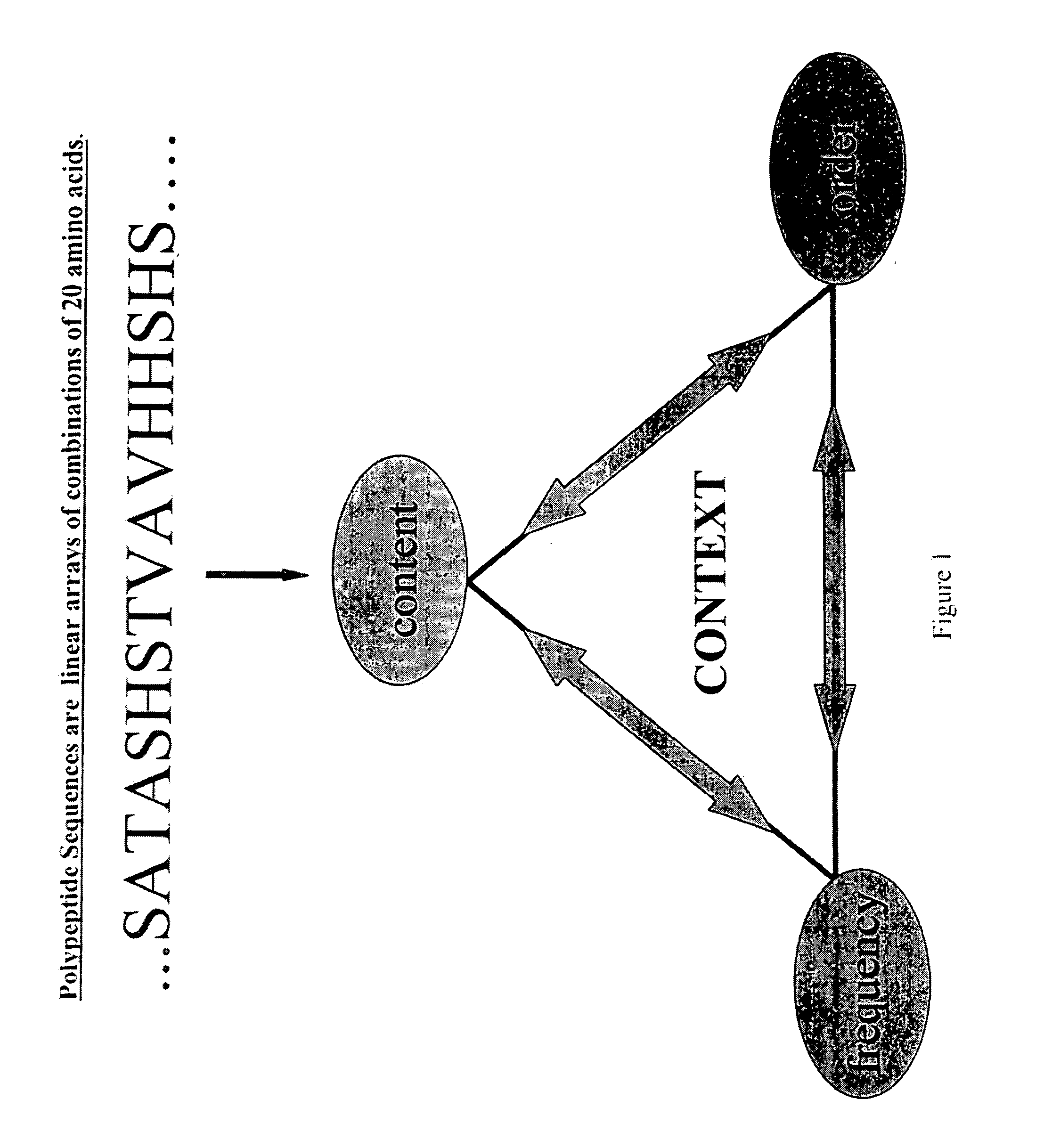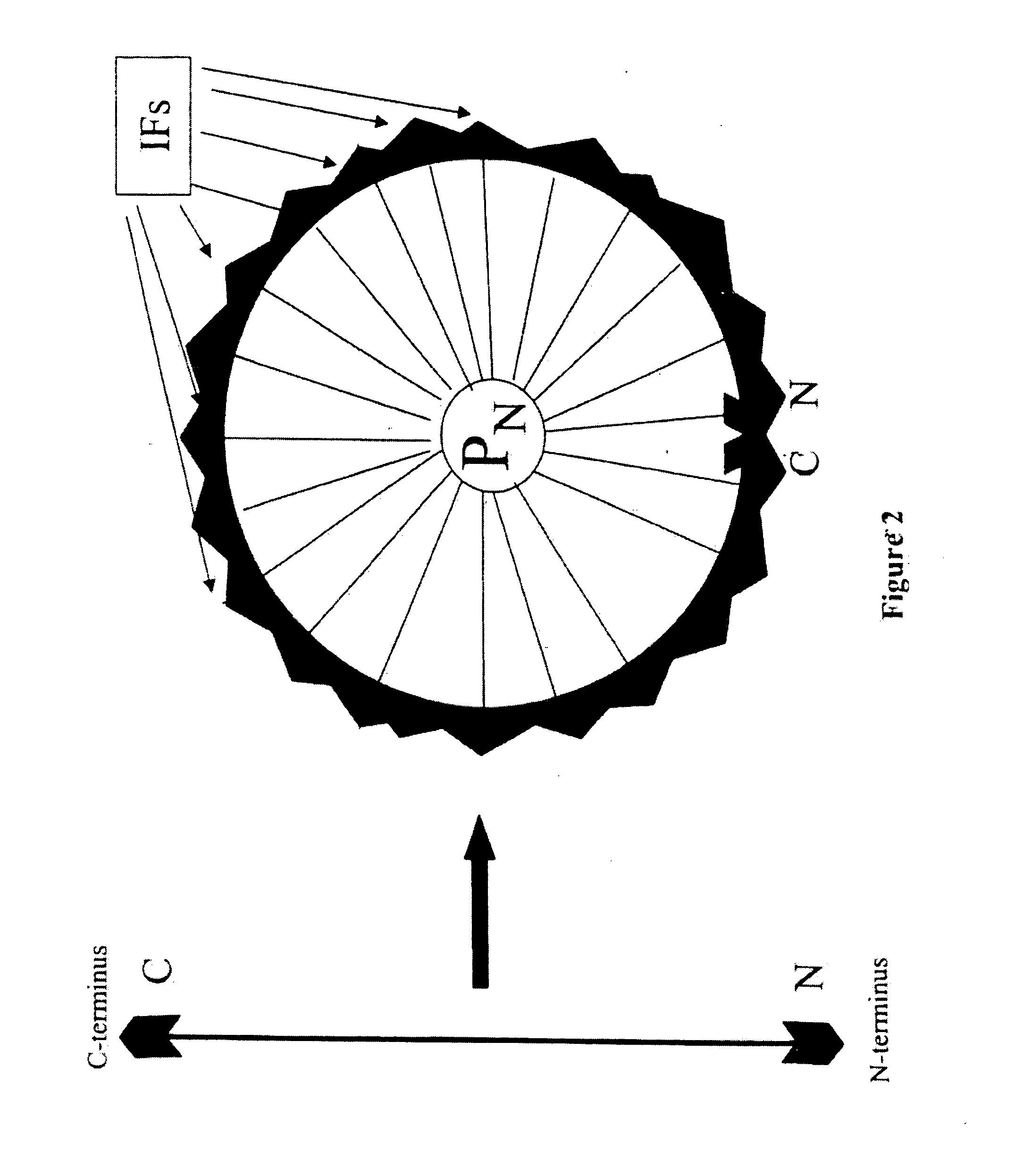Methods for representing sequence-dependent contextual information present in polymer sequence and uses thereof
a contextual information and polymer technology, applied in the field of new methods of representing polymer sequences, can solve the problems of not providing an indication, limited current methods, and unsolved biological sciences
- Summary
- Abstract
- Description
- Claims
- Application Information
AI Technical Summary
Benefits of technology
Problems solved by technology
Method used
Image
Examples
example 1
PVD Construction for HIV Protease
[0195] The PVD emphasizes context properties of frequency and composition. The third property, order or arrangement of monomers, is encoded within the ensemble of PVD's calculated for all positions of a given sequence. Sequence order is inherent in the way each PVD is constructed from the applied impulse function. That is, the PVD at a particular position is calculated from the response of the surrounding primary sequence to a probing pulse applied at that position. If desired, distance dependent contributions and assigned functional properties of chemical, physical or biological characteristics of each monomer unit at every P in the entire sequence can be implemented. By the nature of the impulse function, those monomer units closest to P are usually, but not necessarily, the elements with the largest values of the PVD at P.
[0196] Tables 2 and 3 show a few PVD vectors for HIV protease. The value of each PVD element was determined by summing the pr...
example 2
Determination of Secondary Structural Boundaries in a Folded Protein from the Primary Structure
[0198] PVDs for each amino acid in myoglobin and HIV protease were prepared as described in Example 1 (i.e., using the conditions FDP=I*D*F, where I is a triangular impulse function having width W=20, D=1 / d, and F=1.0). Next, the CLM (X=1) for each PVD was determined and used to construct two-dimensional LMDMs, as shown in FIGS. 6A and 6B. Context centers (including TCC) were identified on the LMDMs and used to parse the sequences into predicted secondary structure units, based upon the rule that each segment of secondary structure would include four context centers. The secondary structure boundaries predicted for myoglobin using this method agree nicely with the boundary predictions determined using DSSP and X-ray crystal structure coordinates (see FIG. 7C).
[0199] Using the same methods, LMDMs were constructed for the IgG binding domain of Protein G and the p53 DNA binding domain, and ...
example 3
Use of the PVD to Identify Protein-Protein Interaction Sites
[0200] PVD values for all NA monomer positions in the sequence of yeast APC11 were determined using the methods of Example 1, with W=3. Next, PVD values for all NB monomer positions in the sequence of protein B (selected from several other yeast proteins, including CDC16, CDC23, CDC26, CDC27, APC2, APC4, APC5, APC9, and DOC1), were determined, also using the methods of Example 1. Potential protein-protein interaction surfaces between APC11 and each of the other yeast proteins were identified by calculating NA×NB difference matrices and plotting the regions of each difference matrix having minimal values, Dij<10% of the maximal difference in the difference matrix. APC11, which is known to interact with all of the B proteins tested, appears to interact with all of the B proteins via its C-terminal region, e.g., about amino acid residues 120-180 (see FIG. 8A). Furthermore, according to the graphs, APC11 has the most extensive...
PUM
| Property | Measurement | Unit |
|---|---|---|
| distance function | aaaaa | aaaaa |
| physical parameter | aaaaa | aaaaa |
| stability | aaaaa | aaaaa |
Abstract
Description
Claims
Application Information
 Login to View More
Login to View More - R&D
- Intellectual Property
- Life Sciences
- Materials
- Tech Scout
- Unparalleled Data Quality
- Higher Quality Content
- 60% Fewer Hallucinations
Browse by: Latest US Patents, China's latest patents, Technical Efficacy Thesaurus, Application Domain, Technology Topic, Popular Technical Reports.
© 2025 PatSnap. All rights reserved.Legal|Privacy policy|Modern Slavery Act Transparency Statement|Sitemap|About US| Contact US: help@patsnap.com



